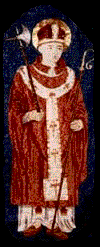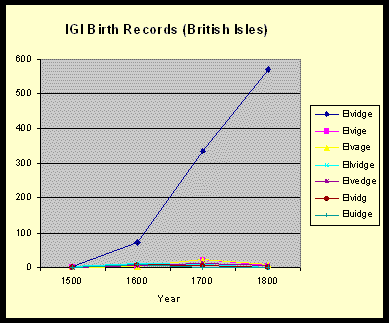



ST. AELFHEAH - The roots of the Elvidge name appear to be the name of the Anglo-Saxon Saint, St. Aelfheah, Archbishop of Canterbury from 1005 through 1012. Aelfheah is also sometimes spelled ELPHEGE, ALPHAGE, or ALPHEGE and was known as "The Elder" or "The Bald." According to a book of English Surnames (source uncertain), St. Alphege's name "survives both in the French pronunciation ELVIDGE and the English ELPHICK." He is credited with restoring monastacism to England.
The Encyclopedia Britannica has this to say about the good saint: "...also called ELPHEGE THE MARTYR, or GODWINE (b. 954, Gloucestershire?, Eng. - d. April 19, 1012, Greenwich, London; feast day, April 19), archbishop of Canterbury who became popularly venerated as a martyr after his death at the hands of the Danes.
Of noble birth, he entered the Benedictine abbey of Deerhurst, Gloucestershire, and later became a hermit at Bath, Somerset, where fervid followers elected him abbot.
Aelfheah was a friend of Archbishop St. Dunstan of Canterbury, through whose influence he was named bishop of Winchester in 984. Aethelred II the Unready, king of the English, sent Aelfheah as ambassador to King Olaf I Tryggvason of Norway, who in 994 entered Britain and whom Aelfheah confirmed and allegedly persuaded not to invade England again.
In 1005 he became the 29th archbishop of Canterbury and immediately went to Rome to receive the pallium (symbol of metropolitan jurisdiction) from Pope John XVIII. Back in England, he called the Council of Enham (1009?) in a futile effort to halt the social demoralization caused by the devastating Danish invasions. On Sept. 8, 1011, the Danes began their sack of Canterbury and seized Aelfheah. He was ill-treated and held seven months without ransom, which he refused to pay with money that the poor would have had to supply as taxes. Aelfheah thereupon was slain by the Danes, after first being pelted with ox bones remaining from their feast.
He was first buried at St. Paul's Cathedral, London, by order of King Canute of Denmark, England, and Norway; his body was removed to Canterbury in 1023 amid great splendour. From the earliest years after his death he was venerated as a martyr. The parish church of Greenwich is dedicated to him."
According to the web site of the St. Alfege Church, "a miracle was reported: a wooden Danish oar dipped in Alfege's blood had sprouted! As a result, his body was taken to St Paul's Cathedral in the city of London. Eleven years later, on 15th June 1023, the body was moved by King Canute to Canterbury Cathedral and placed beneath the North side of the High Altar; a memorial slab now marks the spot where his tomb was. The anniversary of his martyrdom (St Alfege's Day) is 19th April. In 1078 Alfege was canonized; two churchmen, Archbishop Lanfranc and St Anselm agreed that sainthood had been achieved in the cause of divine justice. Possibly, they remembered his last known words; to the Danish cries of "Give us gold", he had replied, "The gold I give you is the Word of God." "
Another interesting Alphege tale comes from ROCA, the collection of Russian Orthodox Materials, where Priest Andrew Phillips writes "In 994 the leader of the Norwegian Vikings, Olaf Tryggvason, laid siege to London, famously destroying London Bridge. Olaf, however, had a change of heart and was chrismated and confirmed at Andover in the south of England by Alphege, Bishop of Winchester, the then English royal capital. When Olaf Tryggvason left England in 995, a new man, he took with him bishops and priests from Winchester and elsewhere in England, including a Bishop Grimkell, an Englishman of Danish origin, who was to become Bishop of the Norwegian capital at Nidaros, now called Trondheim. It was this mission which was to lead to the spreading of Christianity in Norway and the veneration there of such English saints as Saint Swithin of Winchester. In time, the Christian influence of Olaf Tryggvason spread to all future Norwegians, and outside Norway as well. Thus, the Icelandic Kristni Saga and the Saga of Olaf Tryggvason relate how, at his behest, the Christian faith was brought to the Norse settlers in Iceland in about the year 999."
So....from this we learn that one of our ancestors is responsible for the Christianization of Scandanavia! Of course, whether or not this was a good thing or a bad thing is up for debate. :^)

